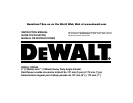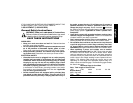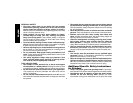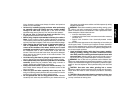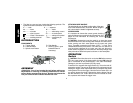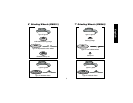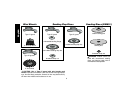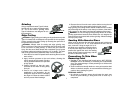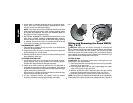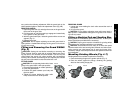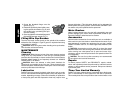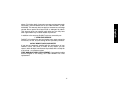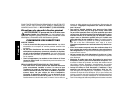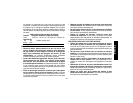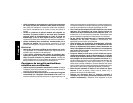
English
3
injury. Accessory ratings must always be above tool speed as
shown on tool nameplate.
• Hold tool by insulated gripping surfaces when performing
an operation where the cutting tool may contact hidden
wiring or its own cord. Contact with a “live” wire will make
exposed metal parts of the tool “live” and shock the operator.
• Do not use Type 11 Flaring Cup wheels on this tool. Using
inappropriate accessories can result in injury.
• Before using, inspect recommended accessory for cracks or
flaws. If such a crack or flaw is evident, discard the accessory.
The accessory should also be inspected whenever you think the
tool may have been dropped. Flaws may cause wheel breakage.
• When starting the tool with a new or replacement wheel, a
new or replacement wire brush installed, or if you are
unsure of the condition of the wheel, hold the tool in a well
protected area and let it run for one minute. If the wheel has
an undetected crack or flaw, it should burst in less than one
minute. If the wire brush has loose wires, they will be detected.
Never start the tool with a person in line with the wheel. This
includes the operator.
• Avoid bouncing the wheel or giving it rough treatment. If this
occurs, stop the tool and inspect the wheel for cracks or flaws.
• Direct sparks away from operator, bystanders or flammable
materials. Sparks may be produced while using a sander or
grinder. Sparks may cause burns or start fires.
• Always use side handle. Tighten the handle securely. The
side handle should always be used to maintain control of the
tool at all times.
• Clean out your tool often, especially after heavy use. Dust
and grit containing metal particles often accumulate on interior
surfaces and could create an electric shock hazard.
• Do not operate this tool for long periods of time. Vibration
caused by tool action may be harmful to your hands and arms.
Use gloves to provide extra cushion and limit exposure by taking
frequent rest periods.
WARNING: Some dust created by power sanding, sawing, grind-
ing, drilling, and other construction activities contains chemicals
known to cause cancer, birth defects or other reproductive harm.
Some examples of these chemicals are:
• lead from lead-based paints,
• crystalline silica from bricks and cement and other masonry
products, and
• arsenic and chromium from chemically-treated lumber
(CCA).
Your risk from these exposures varies, depending on how often you
do this type of work. To reduce your exposure to these chemicals:
work in a well ventilated area, and work with approved safety equip-
ment, such as those dust masks that are specially designed to fil-
ter out microscopic particles.
• Avoid prolonged contact with dust from power sanding,
sawing, grinding, drilling, and other construction activi-
ties. Wear protective clothing and wash exposed areas with
soap and water. Allowing dust to get into your mouth, eyes, or
lay on the skin may promote absorption of harmful chemicals.
WARNING: Use of this tool can generate and/or disburse dust,
which may cause serious and permanent respiratory or other injury.
Always use NIOSH/OSHA approved respiratory protection appro-
priate for the dust exposure. Direct particles away from face and
body.
CAUTION: Use extra care when grinding into a corner
because a sudden, sharp movement of the grinder may be experi-
enced when the wheel or other accessory contacts a secondary
surface.
CAUTION: Wear appropriate hearing protection during use.
Under some conditions and duration of use, noise from this prod-
uct may contribute to hearing loss.



